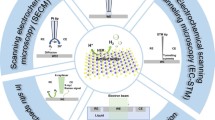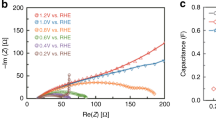Abstract
Electrocatalysts that can reversibly reduce oxygen and oxidise water are of prime importance for the advancement of new emerging electrochemical energy storage and conversion systems. We present in this work the application of scanning electrochemical microscopy (SECM) for characterisation of bifunctional catalysts. By using model bifunctional catalysts based on oxides of cobalt (CoxOy) and nickel (NixOy) embedded in nitrogen-doped carbon (NC), we specifically show the unique ability of using SECM to determine a range of the important electrocatalytic parameters including the selectivity of the oxygen reduction reaction (ORR), the initial mechanistic steps during the oxygen evolution reaction (OER), and the onset potential for both ORR and OER in a single experiment. We were able to observe directly that prior to oxygen evolution, local depletion of oxygen occurs at the SECM tip during redox transition accompanying most likely metal oxyhydroxide formation thus enabling direct in situ observation of the initial mechanistic steps of the OER.







Similar content being viewed by others
References
Girishkumar G, McCloskey B, Luntz AC et al (2010) Lithium-air battery: promise and challenges. J Phys Chem Lett 1(14):2193–2203
Lee J, Kim ST, Cao R et al (2011) Metal-air batteries with high energy density: Li-air versus Zn-air. Adv Energy Mater 1(1):34–50
Christensen J, Albertus P, Sanchez-Carrera RS et al (2012) A critical review of Li/air batteries. J Electrochem Soc 159(2):R1–R30
Jörissen L (2006) Bifunctional oxygen/air electrodes. J Power Sources 155(1):23–32
Gasteiger HA, Kocha SS, Sompalli B et al (2005) Activity benchmarks and requirements for Pt, Pt-alloy, and non-Pt oxygen reduction catalysts for PEMFCs. Appl Catal B 56(1-2):9–35
Sun Z, Masa J, Xia W et al (2012) Rapid and surfactant-free synthesis of bimetallic Pt–Cu nanoparticles simply via ultrasound-assisted redox replacement. ACS Catal 2(8):1647–1653
Rossmeisl J, Qu Z, Zhu H et al (2007) Electrolysis of water on oxide surfaces. J Electroanal Chem 607(1-2):83–89
Lee Y, Suntivich J, May KJ et al. (2012) Synthesis and activities of rutile IrO2 and RuO2 nanoparticles for oxygen evolution in acid and alkaline solutions. J Phys Chem Lett: 399–404
Matsumoto Y, Sato E (1986) Electrocatalytic properties of transition metal oxides for oxygen evolution reaction. Mater Chem Phys 14(5):397–426
Bockris JO (1984) The electrocatalysis of oxygen evolution on perovskites. J Electrochem Soc 131(2):290–302
Trasatti S (1984) Electrocatalysis in the anodic evolution of oxygen and chlorine. Electrochim Acta 29(11):1503–1512
Rincón RA, Masa J, Mehrpour S et al (2014) Activation of oxygen evolving perovskites for oxygen reduction by functionalization with Fe-Nx/C groups. Chem Commun 50(94):14760–14762
Zhao A, Masa J, Xia W et al (2014) Spinel Mn–Co oxide in N-Doped carbon nanotubes as a bifunctional electrocatalyst synthesized by oxidative cutting. J Am Chem Soc 136(21):7551–7554
Chen G, Bare SR, Mallouk TE (2002) Development of supported bifunctional electrocatalysts for unitized regenerative fuel cells. J Electrochem Soc 149(8):A1092–A1099
Park S, Shao Y, Liu J et al (2012) Oxygen electrocatalysts for water electrolyzers and reversible fuel cells: status and perspective. Energy Environ Sci 5(11):9331–9344
Masa J, Xia W, Sinev I et al (2014) MnxOy/NC and CoxOy/NC nanoparticles embedded in a nitrogen-doped carbon matrix for high-performance bifunctional oxygen electrodes. Angew Chem Int Ed 53(32):8508–8512
Paulus UA, Schmidt TJ, Gasteiger HA et al (2001) Oxygen reduction on a high-surface area Pt/vulcan carbon catalyst: a thin-film rotating ring-disk electrode study. J Electroanal Chem 495(2):134–145
Masa J, Batchelor-McAuley C, Schuhmann W et al (2014) Koutecky-Levich analysis applied to nanoparticle modified rotating disk electrodes: electrocatalysis or misinterpretation. Nano Res 7(1):71–78
Eckhard K, Chen X, Turcu F et al (2006) Redox competition mode of scanning electrochemical microscopy (RC-SECM) for visualisation of local catalytic activity. Phys Chem Chem Phys 8(45):5359–5365
Chen X, Eckhard K, Zhou M et al (2009) Electrocatalytic activity of spots of electrodeposited noble-metal catalysts on carbon nanotubes modified glassy carbon. Anal Chem 81(18):7597–7603
Guadagnini L, Maljusch A, Chen X et al (2009) Visualization of electrocatalytic activity of microstructured metal hexacyanoferrates by means of redox competition mode of scanning electrochemical microscopy (RC-SECM). Electrochim Acta 54(14):3753–3758
Wain AJ (2013) Imaging size effects on the electrocatalytic activity of gold nanoparticles using scanning electrochemical microscopy. Electrochim Acta 92:383–391
Sánchez-Sánchez CM, Rodríguez-López J, Bard AJ (2008) Scanning electrochemical microscopy. 60. Quantitative calibration of the SECM substrate generation/tip collection mode and its use for the study of the oxygen reduction mechanism. Anal Chem 80(9):3254–3260
Sánchez-Sánchez CM, Bard AJ (2009) Hydrogen peroxide production in the oxygen reduction reaction at different electrocatalysts as quantified by scanning electrochemical microscopy. Anal Chem 81(19):8094–8100
Eckhard K, Schuhmann W (2007) Localised visualisation of O2 consumption and H2O2 formation by means of SECM for the characterisation of fuel cell catalyst activity. Electrochim Acta 53(3):1164–1169
Okunola AO, Nagaiah TC, Chen X et al (2009) Visualization of local electrocatalytic activity of metalloporphyrins towards oxygen reduction by means of redox competition scanning electrochemical microscopy (RC-SECM). Electrochim Acta 54(22):4971–4978
Dobrzeniecka A, Zeradjanin AR, Masa J et al (2013) Application of SECM in tracing of hydrogen peroxide at multicomponent non-noble electrocatalyst films for the oxygen reduction reaction. Catal Today 202:55–62
Shen Y, Trauble M, Wittstock G (2008) Detection of hydrogen peroxide produced during electrochemical oxygen reduction using scanning electrochemical microscopy. Anal Chem 80(3):750–759
Shen Y, Träuble M, Wittstock G (2008) Electrodeposited noble metal particles in polyelectrolyte multilayer matrix as electrocatalyst for oxygen reduction studied using SECM. Phys Chem Chem Phys 10(25):3635
Masa J, Zhao A, Xia W et al (2013) Trace metal residues promote the activity of supposedly metal-free nitrogen-modified carbon catalysts for the oxygen reduction reaction. Electrochem Commun 34:113–116
Kranz C, Ludwig M, Gaub HE et al (1995) Lateral deposition of polypyrrole lines by means of the scanning electrochemical microscope. Adv Mater 7(1):38–40
Nebel M, Erichsen T, Schuhmann W (2014) Constant-distance mode SECM as a tool to visualize local electrocatalytic activity of oxygen reduction catalysts. Beilstein J Nanotechnol 5:141–151
Nebel M, Eckhard K, Erichsen T et al (2010) 4D shearforce-based constant-distance mode scanning electrochemical microscopy. Anal Chem 82(18):7842–7848
Maljusch A, Ventosa E, Rincón RA et al (2014) Revealing onset potentials using electrochemical microscopy to assess the catalytic activity of gas-evolving electrodes. Electrochem Commun 38:142–145
Trasatti S (1991) Physical electrochemistry of ceramic oxides. Electrochim Acta 36(2):225–241
Krishtalik L (1981) Kinetics and mechanism of anodic chlorine and oxygen evolution reactions on transition metal oxide electrodes. Electrochim Acta 26(3):329–337
Bockris JO, Otagawa T (1983) Mechanism of oxygen evolution on perovskites. J Phys Chem 87(15):2960–2971
Acknowledgments
Financial support from the DFG in the framework of the Cluster of Excellence RESOLV (EXC1069), the Helmholtz-Energie-Allianz “Stationäre elektrochemische Speicher und Wandler” (HA-E-0002) and the BMBF “Sustainable Hydrogen (SusHy)” (03X3581D) is gratefully acknowledged.
Author information
Authors and Affiliations
Corresponding authors
Electronic supplementary material
Below is the link to the electronic supplementary material.
ESM 1
(DOCX 431 kb)
Rights and permissions
About this article
Cite this article
Chen, X., Botz, A.J.R., Masa, J. et al. Characterisation of bifunctional electrocatalysts for oxygen reduction and evolution by means of SECM. J Solid State Electrochem 20, 1019–1027 (2016). https://doi.org/10.1007/s10008-015-3028-z
Received:
Revised:
Accepted:
Published:
Issue Date:
DOI: https://doi.org/10.1007/s10008-015-3028-z




